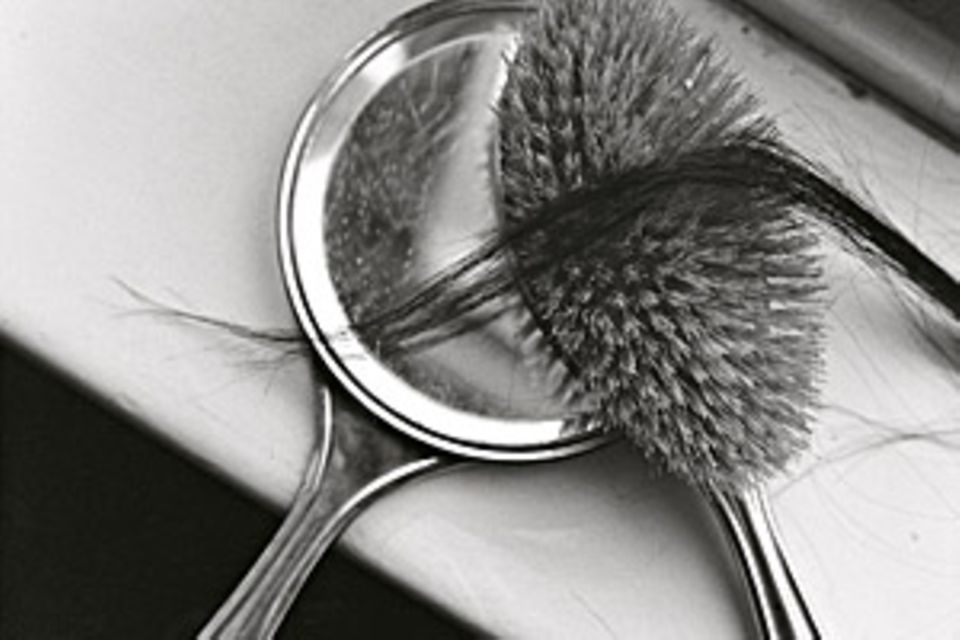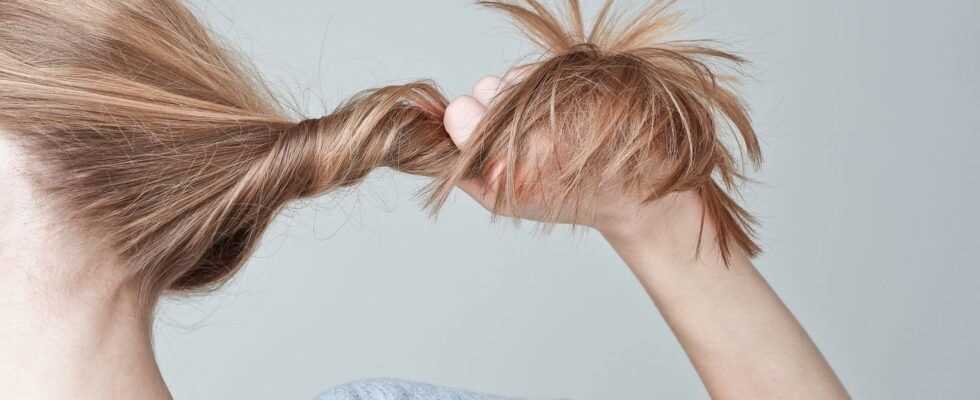Fall can also be to blame: hair falls out. Especially in women, hair loss gnaws at the ego. But there is no need to despair.
Sometimes it's just the time of year: in spring and autumn, a little more than the average of 70 to 100 hairs that people normally lose per day often fall out. Experts suspect that the body is sensitive to the transition from dark winter to longer days – and that excess UV rays trigger too many free radicals after summer. If the hair becomes noticeably thin, there are usually other causes behind it.
How do you recognize pathological hair loss in women?
If hair gets stuck in the shower strainer or brush, we don't have to panic right away. Losing 80 to 100 hairs a day is perfectly normal for women. It only becomes critical when more than 100 hairs fall out every day for weeks. A distinction must be made between two types of hair loss:
1. More and more hair falls out every day, but you can't see it. These hairs are in the so-called resting phase and are no longer supplied by the roots (so-called telogenic effluvium). This hair loss is usually harmless and regulates itself over time.
2. The amount of hair is gradually becoming noticeably less without a particularly large amount of hair falling out (alopecia). In this case, regrowth does not take care of itself. If the hair is thinning, you should definitely have the condition of the hair roots examined by a dermatologist with a hair root analysis (trichogram). The stages of hair growth can be seen under the microscope and a normal from an accelerated cycle can be distinguished. If the majority (more than 80 percent) are in the growth phase, everything is fine. But if most of the hair is in the resting phase, there is usually something wrong.
What are the causes of hair loss?
Hair loss is often seasonal (telogenic effluvium) and accumulates especially in August and September. Experts suspect that more intense sunlight is the cause, but there is no evidence yet. The hair loss lasts a few weeks and then gets better. "But it can also be related to iron deficiency, a thyroid disorder or diseases with a high fever such as malaria or flu. Then the hair loss does not show up until two to four months later. Stress, on the other hand, hardly plays a role," says Professor Dr. Hans Wolff, head of the dermatological clinic and hair clinic at the medical faculty of the Ludwig Maximilians University in Munich. Other possible triggers for hair loss: certain medications (e.g. cholesterol-lowering drugs) or crash diets.
Circular hair loss (alopecia areata) is probably due to a false reaction of the immune system. The most common is hereditary hair loss (androgenetic alopecia). If the mother is affected, the daughter must expect it too. It occurs when the hair roots are over-sensitive to a particularly active form of the male sex hormone (DHT = dihydro-testosterone). This hormone is also produced in the female body. Typical: The hair thins especially in the parting area. (In contrast to men, who develop a receding hairline or a bald spot on the top of the head.) "Overall, around 10 to 15 percent of all women are affected by genetic hair loss," estimates Professor Wolff. "In half, it often doesn't develop until after menopause."
Do certain foods or supplements help with hair loss?
Since iron deficiency, e.g. B. due to increased menstrual bleeding is considered a cause of hair loss, you can at least prevent possible deficits through diet: with liver, soybeans, whole grain bread, peas and carrots. Under no circumstances should you take special iron supplements without consulting your doctor. To strengthen thin, limp hair, you can try coated tablets made from oat, millet and spelled extract, which have a high proportion of the amino acid cysteine, or with capsules that contain millet extract containing silicon, pantothenic acid and wheat germ oil. Silicon gel is also invigorating (health food store, pharmacy). A study by the University Medical Center Hamburg-Eppendorf showed that when taken daily, the hair became around 13 percent thicker after six months.
What role do the hormones actually play?
Female sex hormones (estrogens) ensure, among other things, full, firm and beautifully shiny hair. The estrogen level drops through hormonal changes, for example when stopping the pill, at the end of pregnancy or during the menopause. If then the male hormones predominate, it can lead to increased hair loss.
Can more hair go out through frequent washing?
No, that is a fallacy. Only hair that is no longer supplied by the root and has already died will fall out during washing. However, many women believe that shampooing is the cause and, out of wrong caution, wash their hair less often. Since these can only grow well on a healthy, clean scalp, they should be washed at least twice a week.
Are there any tinctures that can stop hair loss?
"In my opinion, only the active ingredient minoxidil that is contained in the over-the-counter preparation Regaine is effective," says Professor Wolff. "The solution is available in a two percent concentrate for women and a five percent concentrate for men. Studies show that minoxidil not only prevents hair loss, but also that every second woman's hair thickened. This shows up after about three to six months. The active ingredient prolongs the growth phase of the hair, protects the hair shaft and stimulates the roots. However, the preparation must be taken continuously in the case of hereditary hair loss. "
The company L'Oréal relies on other active ingredients after their studies: "Aminexil is an active ingredient that counteracts the hardening of the collagen fibers. This preserves the suppleness and elasticity of the tissue around the hair root, and the hair fiber can be better and more firmly in the The active ingredient SP94 additionally strengthens the hair fiber and builds it up from the inside, "explains Dr. Barbara Ritter, Scientific Director at Vichy.
Tinctures with the active ingredient alfatradiol are also supposed to prevent slight hair loss during menopause (e.g. "El-Cranell alpha", "Pantostin"). A cocktail made from caffeine, zinc, black cohosh and soy is said to strengthen the resilience of fine hair. In a double pack: as a solution to massage into the scalp and as capsules to swallow ("Plantur 39"). Caffeine power can also be found in tonics that stimulate blood circulation (e.g. "Seborin").
Many doctors don't take hair loss seriously. Then who can I turn to?
In any case, you should consult a dermatologist, possibly also a gynecologist or a hormone specialist (endocrinologist) for advice. In some university and dermatological clinics, there are so-called hair consultations, in which doctors deal specifically with the various forms and treatments of hair loss and scalp diseases. New: the first branch of the Danish "Hårklinikken GmbH" in Düsseldorf, which offers a holistic concept.
When should hair loss be treated with hormones?
"In individual cases it can make sense to prescribe a special hormone pill (antiandrogen), for example if a woman also suffers from acne due to an excess of male hormones," says Professor Dr. Hans Wolff.
If you have to resort to hair replacement: which method is recommended?
Steer clear of so-called hair extensions. The false strands are only suitable for extending healthy hair, which should be at least eleven centimeters long. For light areas on the top of the head, a so-called hair thickening, in which the second hair is linked with your own hair, connected with a metal sleeve or simply clipped on, is a good solution. The trick: The "volume filler" has a wide-meshed honeycomb-like network (available for small areas or the whole head) through which your own hair is pulled.
Costs: depending on length, quality and effort, approx. 300 to 1500 euros; Price comparisons are worthwhile. Lasts for weeks – even when doing sports or swimming. Since the hair grows back and loosens in the anchorage, it has to be rewoven every four to six weeks at the hairdresser's (replacement hair specialist); Cost: approx. 70 to 110 euros. Of course, the whole thing only works if you still have enough hair of your own. If not, you can also use wigs. Whether artificial or real hair is a question of the wallet, whereby the price also depends on the processing. Real hair looks more natural and is easier to care for. So that the wig fits the face well, have the hairdresser cut it into shape.
